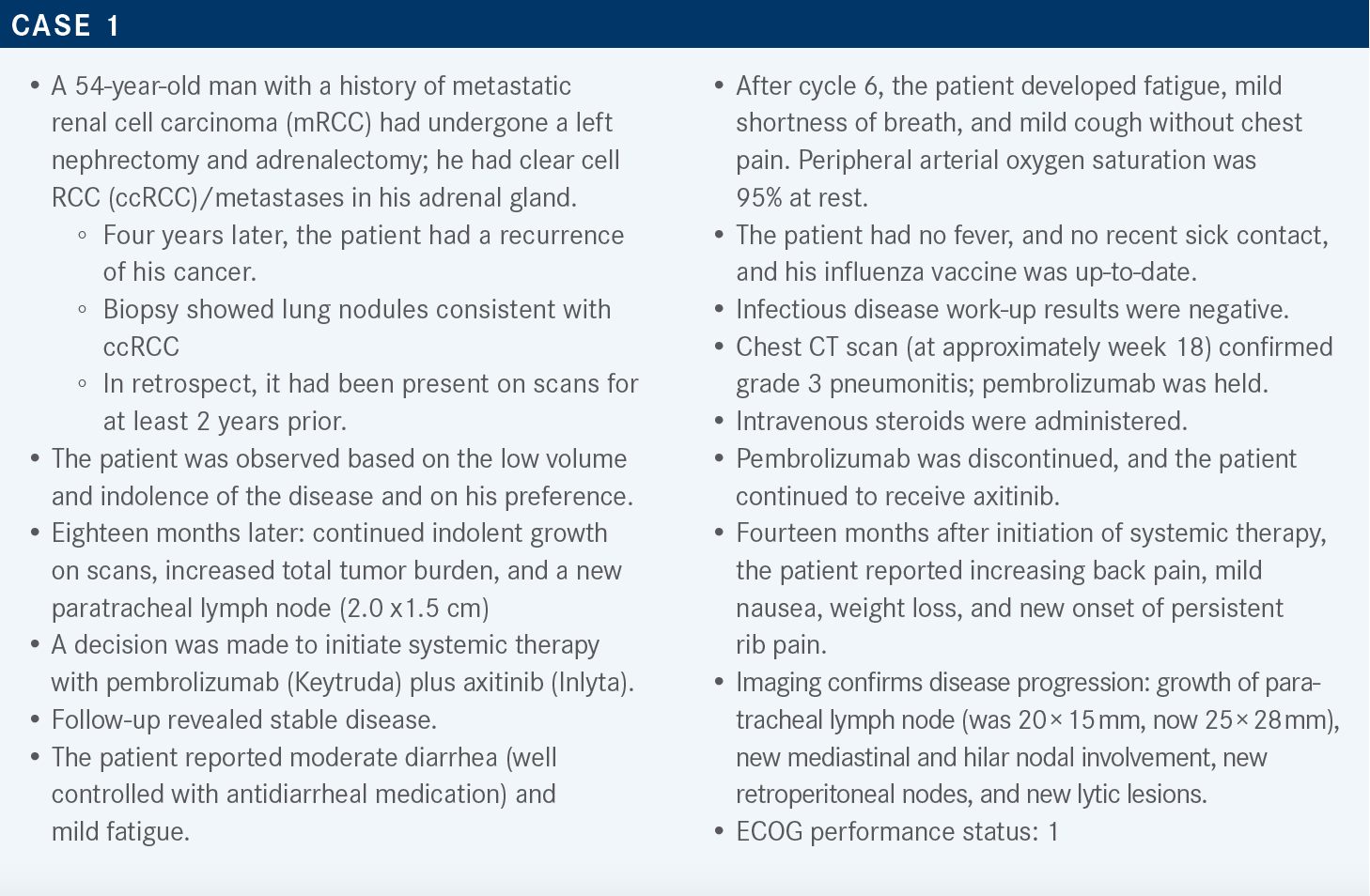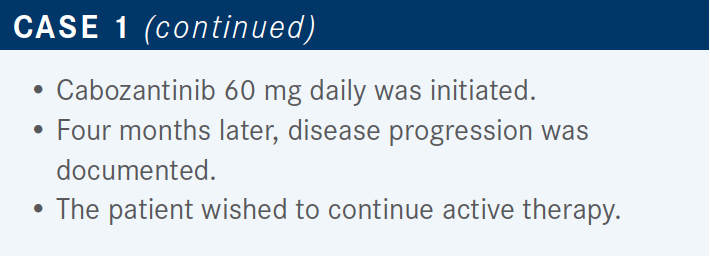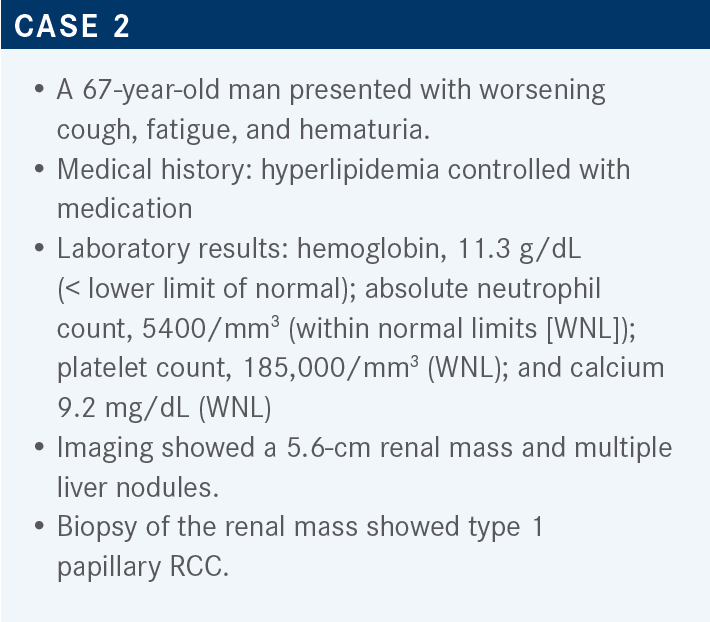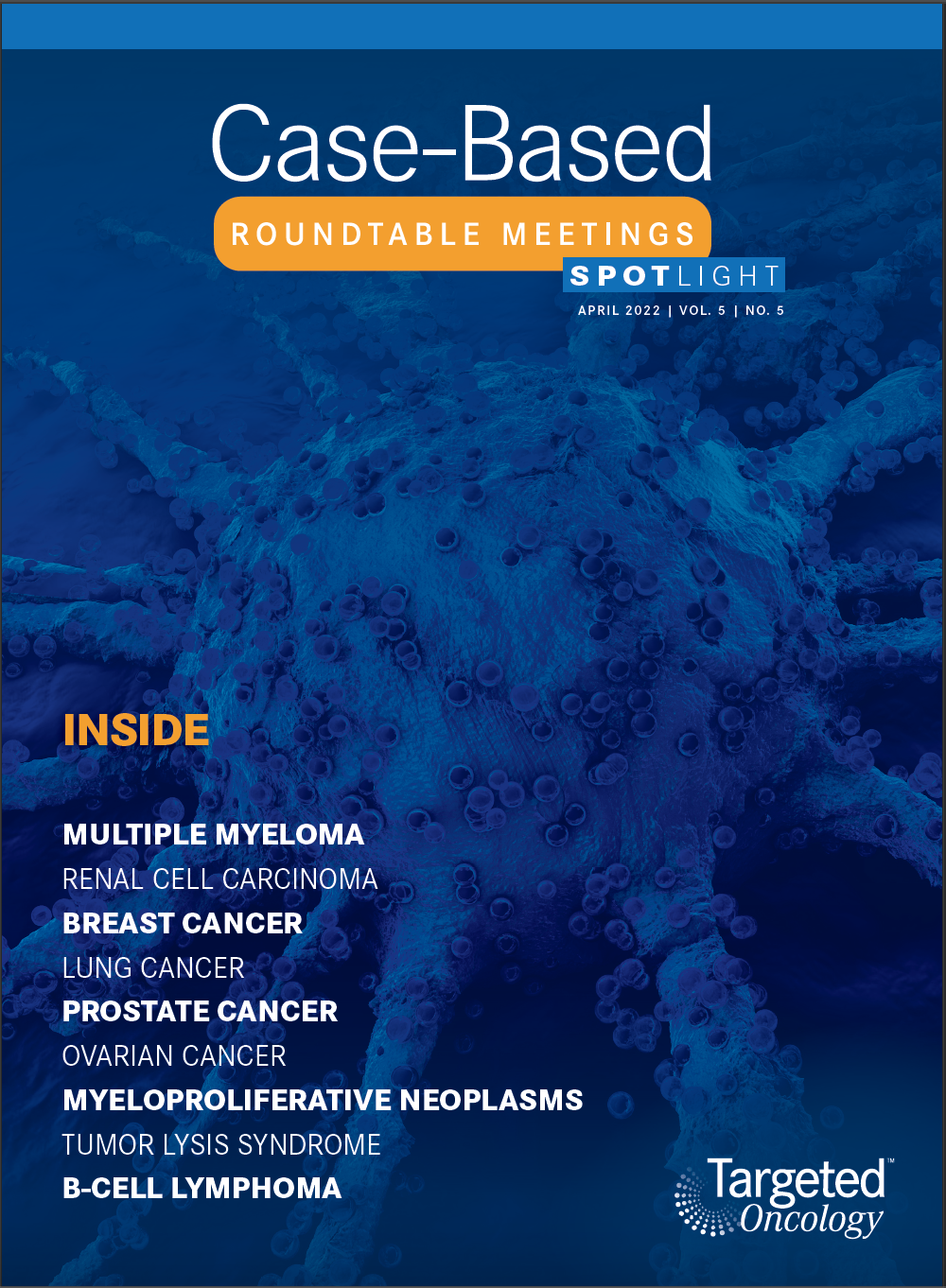Experts Discuss Treatment Options in 2 Patients With Metastatic RCC
Scott S. Tykodi, MD, PhD, and Ulka N. Vaishampayan, MBBS, discussed treatment for patients with relapsed and late-stage renal cell carcinoma based on National Comprehensive Cancer Network guidelines and recent clinical trials.

Scott S. Tykodi, MD, PhD
Associate Professor, Division of
Medical Oncology
University of Washington School
of Medicine
Seattle, WA

Ulka N. Vaishampayan, MBBS
Director of the Phase I Program
Rogel Cancer Center
University of Michigan
Ann Arbor, MI

Targeted OncologyTM: Which second-line therapy are you most likely to recommend for a patient with relapsed/refractory RCC?
VAISHAMPAYAN: According to the National Comprehensive Cancer Network [NCCN] guidelines, cabozantinib [Cabometyx], lenvatinib [Lenvima] plus everolimus [Afinitor], and nivolumab [Opdivo] are the 3 preferred regimens in the second-line setting.1 However, the nivolumab study was done with prior VEGF tyrosine kinase inhibitor [TKI] therapy; now that immune therapy has gone into the front line, there are no data for the use of second-line immune checkpoint inhibitors. There is an ongoing study of cabozantinib plus/minus atezolizumab [Tecentriq], which will hopefully tell us if second-line immune checkpoint inhibitor therapy still has a role.
Other NCCN-recommended regimens include axitinib with or without pembrolizumab, although the patient already [received] those; cabozantinib plus nivolumab; ipilimumab [Yervoy] plus nivolumab; lenvatinib and pembrolizumab; pazopanib [Votrient]; sunitinib [Sutent]—you could go to any of these VEGF TKIs; tivozanib [Fotivda]; and axitinib plus avelumab [Bavencio], which is really low down on the category list [category 3]. Other category 2B or 3 regimens that can be useful in certain circumstances include everolimus, bevacizumab [Avastin], high-dose IL-2, sorafenib [Nexavar], and temsirolimus [Torisel].
These guidelines include some changes that were introduced in July 2021: lenvatinib/everolimus, which previously was in the other recommended regimens, is a preferred regimen; ipilimumab/nivolumab was included in the other recommended regimens; lenvatinib/pembrolizumab and cabozantinib/nivolumab received FDA approval in the front-line setting and can be used in the second-line setting as well.
Another addition was tivozanib, which was approved in March 2021.1,2 The FDA approved it for patients with relapsed or refractory advanced RCC following 2 or more prior systemic therapies. The efficacy of this agent was evaluated in a study called TIVO-3 [NCT02627963], which was a randomized, open-label study of tivozanib compared with sorafenib. Patients were required to have at least 2, but also up to 3, prior systemic therapies. One had to be a VEGF TKI other than sorafenib or tivozanib because of the randomization.3,4
What is the evidence for the preferred NCCN second-line regimens in relapsed/refractory RCC?
The evidence for these recommendations came from a series of clinical trials where patients had prior VEGF TKI therapy and then were randomized to the new agents. CheckMate 025 [NCT01668784] compared nivolumab and everolimus and led to the FDA approval of nivolumab because of an OS [overall survival] benefit; the median survival was 25 months.5 The METEOR trial [NCT01865747] compared cabozantinib and everolimus and found both a PFS [progression-free survival] and an OS benefit.6 Finally, a much smaller phase 1b/2 randomized trial [NCT01136733] compared PFS in patients treated with lenvatinib/everolimus vs lenvatinib or everolimus alone, and appeared to favor the lenvatinib/everolimus combination.7
Overall, the median PFS was 14.6 months with lenvatinib/ everolimus, 7.4 months with cabozantinib, and 4.6 months with nivolumab.5-7 Interestingly, the median OS was pretty similar—21.4 months for cabozantinib—and this is from a bigger study as compared with the lenvatinib/everolimus study, and probably a somewhat more pretreated patient population. None of these studies had patients with prior IO [immuno-oncology] therapy, only prior TKI.
In terms of toxicity, there were some expected grade 3 and 4 toxicities: 71% with cabozantinib [and] 57% grade 3 plus 14% grade 4 with lenvatinib/everolimus. So also 71% overall, which is pretty similar. [Nivolumab was less, at 19% overall.]
Why are VEGF TKIs used so often in RCC?
Kidney cancer can be very dependent on VEGF TKI therapy. The pathophysiology of the disease includes a VHL mutation—which causes overexpression of VEGF—that remains pathogenic throughout the disease course. Additionally, there are a number of VEGF TKIs. Tivozanib is a very selective VEGF TKI; it has activity against all 3 VEGFRs.

What is the evidence for the use of tivozanib in patients with relapsed/refractory RCC?
TIVO-3 was a phase 3, open-label study that enrolled patients with metastatic RCC who had progressed on 2 or 3 prior systemic regimens. That is a highly pretreated patient population. Patients had advanced RCC with a clear cell component, and they were randomized to tivozanib, 1.34 mg daily for 3 weeks on, 1 week off or standard-dose sorafenib, 400 mg twice a day. Treatment was continued until progression or unacceptable toxicity; the primary end point was PFS, and the secondary end points were OS, overall response rate [ORR], duration of response, and safety.8
Patients were grouped by IMDC [International Metastatic Renal Cell Carcinoma Database Consortium] risk categories of favorable, intermediate, and poor risk. The majority of the patients [60%] were in the intermediate-risk group, and the poor- and favorable-risk groups had about 20% each. Most patients had previously taken 2 VEGFR TKIs, and about 30% to 40% of the patients had also been pretreated with cabozantinib.8,9 So this is the only study that has prior therapy with cabozantinib, and it was assessing efficacy. There were a few patients—about 27%—that had prior immunotherapy plus VEGFR TKIs. Because this is a more recent trial, we also have prior IO-based combinations and prior cabozantinib.8,9
One-year PFS was significantly improved with tivozanib therapy [28%] compared with sorafenib [11%]. Additionally, there appears to be a sustained tail end on the curve; the [Kaplan-Meier curves] have continued to stay separate after the first year, although the follow-up is relatively short. The HR [hazard ratio] was 0.73, with a median PFS of 5.6 months with tivozanib vs 3.9 months with sorafenib. Of patients who responded to treatment, 71% in the tivozanib arm and 46% in the sorafenib arm continued to respond for a year or more.10
The ORR was 23% for tivozanib and 11% for sorafenib. The median duration of response was 9 months with sorafenib and 20 months with tivozanib, if patients responded. Otherwise, the stable disease rate was similar between the 2 arms [59% and 58%]. The HR for OS was not statistically significant.8
Please discuss the safety profile observed in TIVO-3.
The most common AEs [adverse events] were hypertension, diarrhea, and fatigue. Tivozanib has similar AEs to other VEGF TKIs, but the rate for grade 3 hand-foot syndrome [1%] is much lower than that of other VEGF TKIs. Although hypertension, diarrhea, and fatigue were relatively common, none of these were grade 4, indicating a lower severity of AEs. So tivozanib is a fairly well-tolerated drug overall. However, a change in voice, mild nausea, and stomatitis were seen in some patients.3
The incidence of serious, grade 3 or higher, TRAEs [treatment-related AEs] was also relatively low: 24% vs 15% for hypertension, 13% vs 12% for asthenia or fatigue, 2% vs 11% for diarrhea, and 1% vs 10% for hand-foot syndrome, for tivozanib vs sorafenib, respectively. So there was a pretty low incidence of significant grade 3 or higher TRAEs.3,9,11
If patients have diarrhea, nausea, or other VEGFR TKI class effects, it’s best to hold the medication and then, depending on how severe it is, you can consider reducing the dose from 1.34 mg to 0.89 mg. The treatment has a built-in break of 7 days; 3 weeks on, 1 week off. Tivozanib can be taken with or without food. If there’s severe diarrhea or another TRAE despite all the supportive medications, then dose reduction is acceptable.12

What treatment would you recommend for a patient with relapsed or stage IV non–clear cell RCC?
TYKODI: According to the most recent version of the NCCN guidelines for systemic therapy for first-line non– clear cell histologies, a clinical trial is recommended; this is a fairly uncommon disease and the feeling is that there is a paucity of data. Otherwise, cabozantinib and sunitinib are the preferred regimens.1
Evidence for sunitinib comes from the ASPEN trial [NCT01108445], in the mid-2010s, which was a head-to-head frontline study of sunitinib vs everolimus. PFS was the primary end point and it was positive for sunitinib.13 In other words, a high-level randomized comparison data set supported choosing a TKI over an mTOR inhibitor and put sunitinib on the map as the preferred drug and, I think, as the standard-of-care comparator for some of the newer agents, including cabozantinib.
Other regimens recommended by the NCCN include lenvatinib/everolimus, nivolumab monotherapy, and pembrolizumab monotherapy. There is also quite a long list of regimens that are useful in certain circumstances, and some of those get into older data or niche subsets.1
Which clinical trials looked at some of these recommended regimens in RCC?
The phase 2 PAPMET trial [NCT02761057], which was presented at the American Society of Clinical Oncology Annual Meeting, was a cooperative group study that enrolled patients with metastatic papillary RCC and no prior sunitinib therapy. It was mostly a frontline trial; a small subset of the patients were allowed to have had a prior treatment, but it couldn’t overlap with the drugs on study. Initially, there were 4 arms in the study.
Sunitinib represented what would be considered a standard of care for the field, then there were cabozantinib, crizotinib [Xalkori], and savolitinib arms. The crizotinib and savolitinib arms were dropped out for futility assessment over the course of the study. So the final version of the study wound up being a 2-arm comparison of sunitinib vs cabozantinib. But there are some data for the other 2 TKIs.14
Crizotinib and savolitinib were selected for being MET-selective TKIs. Germline MET mutations predispose to papillary RCC, although the reverse is not that commonly true. Sporadic papillary RCC tumors can have MET mutations, but those are vanishingly rare. There can be other derangements in METs, such as gene amplification by chromosomal duplications, so it’s a little bit of a muddy molecular phenotype.
Cabozantinib wears both hats; it’s a highly potent VEGF-selective inhibitor but also inhibits MET. So that’s a lovely drug that targets 2 pathways thought to be relevant to papillary RCC. As mentioned above, sunitinib is a VEGF-selective agent. The primary end point for the study was PFS, and several secondary end points included OS, ORR, AEs, and the exploratory evaluation of MET mutational status and expression.14 There were about twice as many patients with type 2 histology, as assessed by an outside pathologist or by central pathology review, than those with type 1.
The IMDC risk categories were also mixed in a way that is typical for most studies, with [one-fourth] of patients in the favorable-risk group; a little bit more than half in the intermediate-risk group; and 14% in the high-risk group.14
What was the efficacy of the different arms in the PAPMET trial?
Kaplan-Meier analysis of cabozantinib vs sunitinib showed a median PFS of 9 vs 5.6 months [HR, 0.60; 95% CI, 0.37- 0.97; P = .01].14 So this was a positive study. On the other hand, the MET-selective TKIs [crizotinib and savolitinib] fared quite poorly, with half the patients progressing on their first scan.14 So [there was] not much activity for those drugs.
Cabozantinib had a 23% objective response rate compared with 4% for sunitinib [P = .010]. In terms of OS, cabozantinib is incrementally better than sunitinib, 20 months vs 16.4 months, though the HR and P value were nonsignificant [HR, 0.84; 95% CI, 0.47-1.51]. At least the trend favors the drug we perceive to be more active. For the other 2 arms, it was 0% for crizotinib and 3% for savolitinib. So these drugs had a poor performance by PFS, the primary end point, and by objective response, meeting a futility end point and being stopped.14 However, an intriguing aspect is that the survival curves for cabozantinib and crizotinib are nearly identical.
There’s certainly precedent for our IO drugs, where the response phenotype, or PFS, doesn’t always translate faithfully to OS, and the OS looks better than you might have predicted. [But] that phenotype doesn’t cross over that well to targeted drugs or chemotherapy.
You also have to be cautious about drawing conclusions from small cohorts. Sometimes you just get tricked by the data. But one suggestion I would [make] is that the salvage therapy beyond the study may be very impactful. So what you give people in the second line…might be a wash for how good or bad you appear to fare in the first-line setting. And we do have another whole class of drugs; we have IOs.
Perhaps that is the great equalizer, and what you get in the second line is very impactful. The study controls what you get until you fail, so the response rate and the PFS are governed by the study and the drugs being delivered on behalf of the study. So, those clearly represent differences in the drugs under study. But when you start looking at OS, you’re measuring a lot of events that are happening beyond the timeline of the study, and it gets muddy. That’s always one of the challenges of measuring an OS outcome. But I do find these curves to be curious. There’s not quite as much separation as you might have guessed.

If this patient were to progress, what would you recommend next?
The point I wanted to make with the PAPMET trial, and the survival analysis, is that maybe the therapy given beyond the TKI was impactful. And so what other drug classes do we have? We have IO therapy, and KEYNOTE-427 [NCT02853344] was a front-line, pembrolizumab monotherapy, single-arm study. It had 2 cohorts—cohort A was clear cell RCC and cohort B was non–clear cell RCC—and it enrolled 165 patients.15 I believe this is the largest non–clear cell RCC study, even though it’s a single-arm study. So it’s quite a robust data set, and this was published in the Journal of Clinical Oncology.
This was a frontline therapy study, so patients had no prior systemic therapy and had to have a good performance status. Pembrolizumab was given in the conventional way, 200 mg every 3 weeks. The primary end point was response rate and the secondary end points included OS, PFS, duration of response, and safety.15
In terms of baseline patient characteristics, the study was conventional, with 32% of the patients in the favorable-risk group and the other two-thirds in the intermediate- and poor-risk groups, which is typical. A high fraction [62%] of patients were positive for the Merck/ Dako North America PD-L1 [IHC 22C3 pharmDx] assay. Patients with all non–clear cell histologies were enrolled, but most [71%] had papillary non–clear cell RCC, which is the most common non–clear cell type. The remaining 30% of patients had either chromophobe or unclassified histology.15
How did patients do on pembrolizumab monotherapy?
Over half the patients [55%] had a decrease in target lesions and 35% had 30% shrinkage, the target objective response criteria.15 So [it’s] a fairly active drug, pembrolizumab, as monotherapy for these patients.
Of the entire 165-patient cohort, the response rate was 26.7%. But for papillary non–clear cell RCC, which is relevant to the case we’re talking about, it was 28.8%. There were a handful of complete responses, 7 patients in total, 6%. The rest were partial responses and some stable disease.15 In comparison, the response rate for cabozantinib in the PAPMET trial was 23% to 25%. So this is looking very good, and comparable to front line TKI.
PFS was 4.2 months [95% CI, 2.9-5.6]—which doesn’t sound very exciting but that’s the theme of IO drugs, [in which] PFS is often not a good number—but the OS is what carries the day. OS was 28.9 months [95% CI, 24.3-not reached], which is incrementally better.15
The PAPMET data had about 20 months for cabozantinib. So the numbers for single-agent pembrolizumab compare well to the front-line comparison PAPMET study.
What other studies do you feel are relevant in this space?
There are also front-line data with the doublet lenvatinib plus everolimus in a fairly small study of patients with non–clear cell RCC [NCT02915783]. This was a front-line study, so patients had no prior therapy and a good performance status. There was a conventional use of the doublet with the standard starting doses: lenvatinib, 18 mg; everolimus, 5 mg. The primary end point was response and the secondary end points were PFS and OS.16
There were only 31 patients, of whom 20 [two-thirds] had papillary histology. The stratification by IMDC risk factor was as expected.16
There was some activity, a few responders, and some tumor regression that did not meet the objective response criteria. Three patients met the partial response criteria, corresponding to 15% of the papillary group. There were no complete responders. However, 70% of the patients had stable disease, and 85% had disease control with this doublet.16
So [results were] better in terms of disease control than depth of response. Patients with chromophobe histology fare reasonably well with everolimus-based regimens and did so here too [ORR, 44%].16
The median PFS was 9 months; that comes close to overlapping with the TKI data. The median OS was 15.6 months.16 This study had fewer patients than the others and quantitatively it was a little bit inferior to the other data sets.
REFERENCES
1. NCCN. Clinical Practice Guidelines in Oncology. Kidney cancer, version 4.2022. Accessed March 7, 2022. https://bit.ly/3tcwJXG
2. FDA approves tivozanib for relapsed or refractory advanced renal cell carcinoma. FDA. March 10, 2021. Accessed March 7, 2022. https://bit.ly/3I7Q3cY
3. Rini BI, Pal SK, Escudier BJ, et al. Tivozanib versus sorafenib in patients with advanced renal cell carcinoma (TIVO-3): a phase 3, multicentre, randomised, controlled, open-label study. Lancet Oncol. 2020;21(1):95-104. doi:10.1016/ S1470-2045(19)30735-1
4. Szarek M, Needle MN, Rini BI, et al. Q-TWiST analysis of tivozanib versus sorafenib in patients with advanced renal cell carcinoma in the TIVO-3 study. Clin Genitourin Cancer. 2021;19(5):468.e1-468.e5. doi:10.1016/j.clgc.2021.03.018
5. Motzer RJ, Escudier B, McDermott DF, et al; CheckMate 025 Investigators. Nivolumab versus everolimus in advanced renal-cell carcinoma. N Engl J Med. 2015;373(19):1803-1813. doi:10.1056/NEJMoa1510665
6. Choueiri TK, Escudier B, Powles T, et al; METEOR Investigators. Cabozantinib versus everolimus in advanced renal cell carcinoma (METEOR): final results from a randomised, open-label, phase 3 trial. Lancet Oncol. 2016;17(7):917-927. doi:10.1016/S1470-2045(16)30107-3
7. Motzer RJ, Hutson TE, Glen H, et al. Lenvatinib, everolimus, and the combination in patients with metastatic renal cell carcinoma: a randomised, phase 2, open-label, multicentre trial. Lancet Oncol. 2015;16(15):1473- 1482. Published correction appears in Lancet Oncol. 2018;19(10):e509. doi:10.1016/S1470-2045(15)00290-9
8. Verzoni E, Escudier B, Hutson TE, et al. TIVO-3: durability of response and updated overall survival of tivozanib versus sorafenib in metastatic renal cell carcinoma (mRCC). J Clin Oncol. 2021;39(suppl 15):4546. doi:10.1200/ JCO.2021.39.15_suppl.4546
9. Escudier B, Rini BI, Pal SK, et al. TIVO-3: age-related tolerability outcomes of tivozanib versus sorafenib in metastatic relapsed or refractory renal cell carcinoma, a subgroup analysis of the TIVO-3 clinical trial. J Clin Oncol. 2021;39(suppl 15):e16553. doi:10.1200/JCO.2021.39.15_suppl.e16553
10. Pal SK, Escudier BJ, Atkins MB, et al. Final overall survival results from a phase 3 study to compare tivozanib to sorafenib as third- or fourth-line therapy in subjects with metastatic renal cell carcinoma. Eur Urol. 2020;78(6):783-785. doi:10.1016/j.eururo.2020.08.007
11. Pal SK, McDermott DF, Escudier B, et al. Temporal characteristics of treatment-emergent adverse events and dose modifications with tivozanib and sorafenib in the phase 3 TIVO-3 study of relapsed or refractory mRCC. J Clin Oncol. 2021;39(suppl 15):4567. doi:10.1200/JCO.2021.39.15_suppl.4567
12. Fotivda. Prescribing information. AVEO Pharmaceuticals, Inc; 2021. Accessed March 9, 2022. https://bit.ly/3I7QqEo
13. Armstrong AJ, Halabi S, Eisen T, et al. Everolimus versus sunitinib for patients with metastatic non-clear cell renal cell carcinoma (ASPEN): a multicentre, open-label, randomised phase 2 trial. Lancet Oncol. 2016;17(3):378-388. doi:10.1016/ S1470-2045(15)00515-X
14. Pal SK, Tangen C, Thompson IM Jr, et al. A comparison of sunitinib with cabozantinib, crizotinib, and savolitinib for treatment of advanced papillary renal cell carcinoma: a randomised, open-label, phase 2 trial. Lancet. 2021;397(10275):695-703. doi:10.1016/S0140-6736(21)00152-5
15. McDermott DF, Lee JL, Ziobro M, et al. Open-label, single-arm, phase II study of pembrolizumab monotherapy as first-line therapy in patients with advanced non-clear cell renal cell carcinoma. J Clin Oncol. 2021;39(9):1029-1039. doi:10.1200/ JCO.20.02365
16. Hutson TE, Michaelson MD, Kuzel TM, et al. A single-arm, multicenter, phase 2 study of lenvatinib plus everolimus in patients with advanced non-clear cell renal cell carcinoma. Eur Urol. 2021;80(2):162-170. doi:10.1016/j.eururo.2021.03.015

Enhancing Precision in Immunotherapy: CD8 PET-Avidity in RCC
March 1st 2024In this episode of Emerging Experts, Peter Zang, MD, highlights research on baseline CD8 lymph node avidity with 89-Zr-crefmirlimab for the treatment of patients with metastatic renal cell carcinoma and response to immunotherapy.
Listen
Beyond the First-Line: Economides on Advancing Therapies in RCC
February 1st 2024In our 4th episode of Emerging Experts, Minas P. Economides, MD, unveils the challenges and opportunities for renal cell carcinoma treatment, focusing on the lack of therapies available in the second-line setting.
Listen